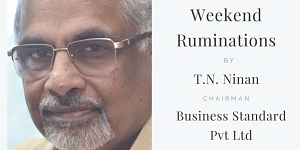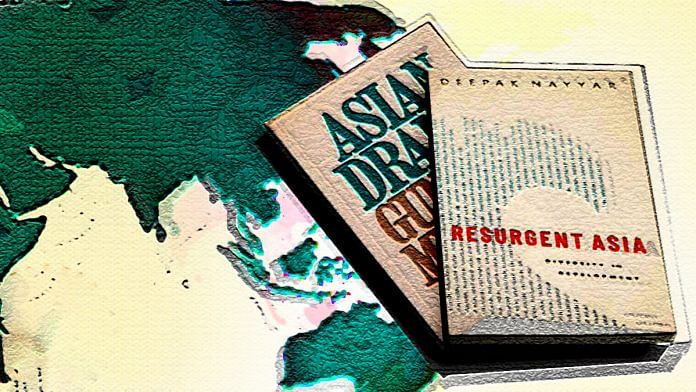When Gunnar Myrdal was writing his three-volume Asian Drama in the late 1960s, no one would have dreamt that Bangladesh, which was shortly to suffer from the deadliest tropical cyclone ever recorded, and then a liberation war, would emerge as a star economic performer 50 years later. The country that was dismissed by Henry Kissinger as an international basket case has now beaten its South Asian neighbours on both human development indicators and economic growth rates. Its per capita income of $1,905 compares with Pakistan’s $1,388, and is not far behind India’s $2,171.

Myrdal’s book is often referred to as monumental, being all of 2,300 pages. But he got many things wrong, including whether population would be a deadweight (today China and India owe their large internal markets to population growth), but he also got some things right (like, initial conditions matter). And some passages in Asian Drama read like little better than journalism. Still, Deepak Nayyar has chosen the book’s 50th anniversary to revisit Asia (Resurgent Asia: Diversity in Development).
Nayyar’s story is nuanced, pointing to the different paths that countries in the region followed, often as a consequence of colonialism’s role in opening up closed markets. Shashi Tharoor in An Era of Darkness has speculated on whether India could have made it if it had not been colonised and given the railways and a modern administration (he thinks it would have), but it is certainly true that without external influence, many countries of the region would not have introduced land reforms. Nor were Taiwan and South Korea countries that took to exports like ducks to water; they experimented with import substitution before they realised that their home markets were too small.
Also read: How Asia transformed from the poorest continent to a global economic powerhouse
How much of the “Asian miracle” owes its success to autocratic rulers, and how were those rulers different from today’s Erdogan, on whose watch Turkey’s economy has tanked? Or other autocrats like Putin, whose Russia survives by exporting oil, gold, coal, timber, and armaments, while that other BRICS economy, Brazil, still flatters to deceive with its modest growth rates? How were Asia’s leaders of yore different from our own Narendra Modi in their understanding of what it takes to get an economy on to a higher plane?
While refusing to get into the democracy vs authoritarianism argument, other than to say that democracy is an end in itself, and that it is more conducive to checks and balances, Nayyar concedes that political democracy is neither necessary nor sufficient for economic development. He suggests that a Weberian bureaucracy was as much responsible for the success of the leading economies of Asia. Given that the economies of Asia range from communist to capitalist, and Myrdal’s observation that the same solutions in different countries seem to produce different outcomes, should India be willing to experiment more with administrative arrangements — which necessarily imply greater decentralisation?
Will this be an Asian century? Nayyar thinks not, perhaps because only two or three countries in the region have reached high-income status. But if one looks through the BRICS prism, the shift in the balance of power seems a foregone conclusion. The four BRICS countries were supposed to account for half the GDP of the six leading Western economies by 2025; they are already past that landmark — having got there from 15 per cent in 2003. The reason is how well the two Asian giants have done — but their natural rivalry will prevent them from acting together in pursuit of common objectives.
In the half-century since Asian Drama was written, India has missed the bus more than once. If we now want to avoid being dragged into a Hobbesian world dominated by one or two Leviathans, India needs to figure out whether it pays to be rule-takers or seek to be rule-setters (for instance, in a regional trading arrangement). Or, do we really have an answer to China’s strategic challenge? If not, what are our options? At the cusp of the century’s third decade, these and other questions flowing from Asia’s history of the last 50 years need urgent answers.
By Special Arrangement with Business Standard
Also read: Asia will have world’s largest GDP in 2020 — China and India to contribute the most







India had a reasonably good consumer electronics industry in the 1980s-90s. Onida. Weston. Bush. To name a few.
But MMS’s reforms washed away everyone. Not one survived.
Sam Pitroda, who gave up his US citizenship with much fanfare, should now have been competing with Huwaei for 5G. Now just the thought is laughable.
This negative contribution of MMS’ reforms has not been well analyzed. He did best what he knew: economics. But I don’t think he had a feeling for what is required to nurture industry.
Are you dumb, The only good thing MMS did was opening market in 1991.
Rajvir is back in full form!
If Onida, Weston, Bush were good they would have survived. Just like Indian car manufacturers, who started making cars before Japan, but failed to improve their products and were caught napping, Indian electronic manufacturers met the same fate. This is a larger malaise of Indian industry which seeks protection from competition and is better at lobbying government than making quality products. No point in blaming MMS
In every successful country in Asia, it’s been the government that has helped industry. Japan. South Korea. China. Singapore. You name it.
Opening up an economy also requires some preparation. So while MMS went about dismantling controls, he should’ve also had a plan for bringing up Indian industry up to world standards.
And don’t blame only Indian companies. They are as good as the engineers available. Indian engineering colleges don’t produce good engineers suited for taking India into the modern world.
China is still doing it to this day.
The much maligned Modi also tried to do it with his Make in India campaign. But he got side-tracked by useless things like Demon.
The other problem has been companies like Infosys who neither made software products nor invested in hardware development. Most of their revenue is only from software support.
It’s not going to be easy for India to come out of this cul-de-sac.
Indian engineers can only be as good as those who train them. As you mentioned about Infosys, most Indian companies do no product development nor do they play any part in training engineers by offering apprenticeships. The reason being that Indian companies don’t need engineers as they indulge only in support and maintenance. For eg software support can make do with science, arts and commerce graduates trained in application software. Unlike say in the US, there is zero interaction between Indian industry and engineering colleges except during placement season. Neither do Indian companies sponsor any university led research or projects nor do they interact in any other way with colleges.
Yes. You’re right on many points.
But it’s a loop. Bad engineers prepare bad engineers.
The making of an engineer starts in school. And it’s very difficult to compensate for bad technological training in school and university later.
Clearly, my argument is applicable to the average person. Intelligent people are able to learn on their own.
That’s why I’m pessimistic about India’s technological future: even if you start today to change the curriculum in the school, it will take a generation for the effect to be felt.
MMS’ reforms had a perverse side effect: it sucked in a lot of good brains into finance, because that is where the money was.
Also, the role of the (non) contribution of NRIs has to be examined. Their absence from the development of India is noteworthy. China has won there too.
The train has already left the station and is not even visible, with India stranded on the platform.
Modi 1.0 could have seen India play catch up with China. But he, like Mohammad Bin Tughlaq, launched a number of quixotic initiatives that killed all hope of India catching up with China.
To see the real crisis, just see what’s available on Amazon that is made in India compared to China.
No other country – least of all one with one sixth of the world’s population and most of its poor – seems as intent as chucking it all away.
Bangladesh did not exist when Myrdal published Asian Drama.
To call Indian bureaucracy Weberian would be a joke (not that the author does).